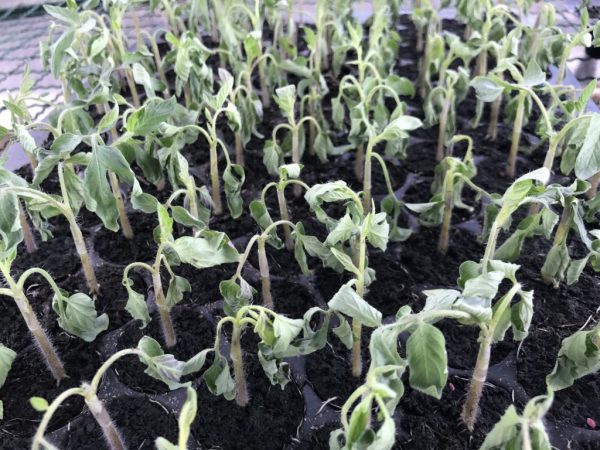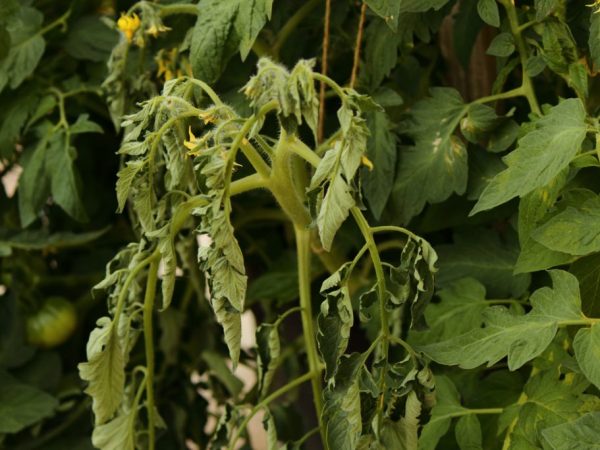How and how to treat tomatoes from root rot
The fungus on the tomato can ruin the whole future harvest. Seeds, seedlings, healthy bushes are equally susceptible to fungal diseases, expressed by different external symptoms. Rot on fruits and leaves should alert the gardener. Only timely treatment of tomatoes from root rot with the help of home-made and purchased means will save the crop.

Treatment of tomatoes from root rot
Tomato root rot is difficult to get rid of, and every day of delay leads to the rapid spread of fungal disease. Eating contaminated fruit is dangerous. The destruction of infected stems and processing of weak tomatoes in the treatment of rot is indispensable.
Characteristics of the disease
Such a phenomenon as root and root rot is familiar to every experienced gardener. Pathogenic fungi, getting into a favorable environment, quickly spread through healthy plants. Neighboring crops can suffer from pathogenic microorganisms: cucumbers or cabbage. Root rot of tomatoes affects plants at any stage of development. Seedlings in a greenhouse are not immune to fungal diseases. Rot appears on crops planted outdoors and protected in a greenhouse.
Danger of fungal rot:
- occurs at any time of the year;
- affects tomatoes in a greenhouse and on an open land;
- spreading rapidly;
- carried by the wind from a diseased crop to healthy plants;
- carried by insects and through inventory;
- penetrate the plant through cuts and breaks.
From tomato root rot disease, you can lose all seedlings. It is very difficult to harvest a good harvest from infected bushes, and fungal spores remain in the soil and threaten new crops in the future.
If diseased plants are not treated, all nearby bushes will gradually wither. To prevent such a problem, the gardener should pay special attention to planting and fertilizing tomatoes.
Signs of the decay process
It is not difficult to recognize the signs of a fungal disease if the crop is properly cared for. First of all, rot affects the root part of tomatoes, and the disease manifests itself in other signs:
- most of the stem is thinning;
- the stems begin to "lean" to the ground;
- seedlings die almost immediately;
- leaves dry out in the sun (after the leaves fall off, new leaves appear, which soon also dry up);
- the stem is covered with dark spots;
- the leg of the plant gradually turns black.
The general tone of the plant is sharply deteriorating, which is difficult not to notice even for a novice gardener. The shoots that appear do not have time to grow and immediately die. The appearance of new foliage is only a temporary improvement in the condition of the stem.
As soon as the leg of the tomato begins to turn black, the treatment of the diseased stem becomes more difficult. During the period when the "symptoms" of a fungal disease appear, abundant watering of the plant stops. It is worth protecting the diseased culture from the rapid spread of the fungus.
Plant healing

Withering plants can still be saved
After identifying root rot in tomatoes, the gardener carries out a number of sequential measures. Only those plants that have begun to wilt are treated, but bushes with black stems and legs cannot be saved. Tomatoes (seedlings or bushes) can be cured with folk recipes on a natural basis or with means that are designed to combat rot. Plant treatment includes thorough soil treatment, transplanting seedlings and further prevention of the disease.
The soil must be fertilized in a modern way: before planting it is disinfected, during the growing period of tomatoes it is fed with 1 or more fertilizers, after jigging diseased specimens, the soil is again cleaned and dried out. To prevent the soil from tolerating fungal spores, it should be prepared before planting and fertilized after it - for planting other crops.
Home treatment
The root disease of tomatoes, and among the common people, "rot" is an infection that can damage tomatoes through cucumbers or other infected plants. The soil is the carrier of the disease, so the root is the first to suffer. The root infection is removed with homemade remedies. Composition of effective solutions:
- potassium chloride (add 30 grams of potassium powder to a bucket of 10 liters of water);
- calcium nitrate (about 5 drops per liter of purified water);
- superphosphate (about 10 grams) dissolved in a liter of warm water.
To prevent rot from spreading to other crops, it is necessary to carefully process the leaves and stems of neighboring crops. For tomatoes, use milk whey with water (useful components can be added).
Use a homemade preparation to remove rot from the fruit and root of the stems. For tomatoes, homemade products are safe. The frequency of processing tomatoes (the root system is processed) should not exceed three times a week.
Drug treatment methods
Root rot in tomato plants is treated with inexpensive store-bought remedies. If fungi are found in the greenhouse or in the garden, the tomato is treated in several stages: the spoiled stems are cut off and the places of the cuts are sprinkled with sulfur. Small damage to tomatoes (in seedlings and bushes) must be treated with colloidal sulfur.
In a greenhouse or in a vegetable garden, the plant is treated with Cuproxat (dilute one part of the drug into two parts of water). Bordeaux liquid shows good results in the fight against infection in tomatoes, regardless of where they are planted (in the field or in a greenhouse). The purchased powder is diluted in 1 liter of water. Purchased products should be alternated with natural solutions to protect plants from fungus.
Prophylaxis
Prevention is always easier than destroying diseased shoots. The prudent gardener fertilizes the soil in advance and strengthens the plant in order to get a good harvest soon.
Prevention is carried out until autumn, and before harvesting, only natural or homemade fertilizers are used:
- Before planting in a greenhouse, it is best to choose varieties that are resistant to fungal disease.
- The soil for planting is thoroughly heat treated. Additionally, the soil is washed with a solution of potassium permanganate (a few drops of the drug are diluted per liter of water) and dried.
- Seedlings are planted (in a greenhouse or on an open land) at a short distance from each other. Crowded landing should not be allowed.
- The soil is fertilized with wood ash.
- Mineral complexes are used to fertilize the soil twice a month.
- Bushes are treated with the drug "Fitosporin" once a month.
- Diseased shoots are immediately removed from the bushes.
An important condition for proper prevention is systematicity and consistency. If the farmer has a schedule for watering and fertilizing the soil, the chances of a fungal infection are very small.
Fungal diseases multiply faster in a humid environment, so the greenhouse is periodically cleaned of moisture (remains on the walls or film).Natural additives such as whey can help protect the plant from any external threat. For these purposes, 1 part of whey and 1 part of water are diluted.
Conclusion
Tomatoes are unpretentious crops that require little maintenance. If a problem arises and the root system of the plant begins to rot, the gardener should take drastic measures: remove diseased stems, process all nearby bushes and strengthen the weakened stems before harvesting.


